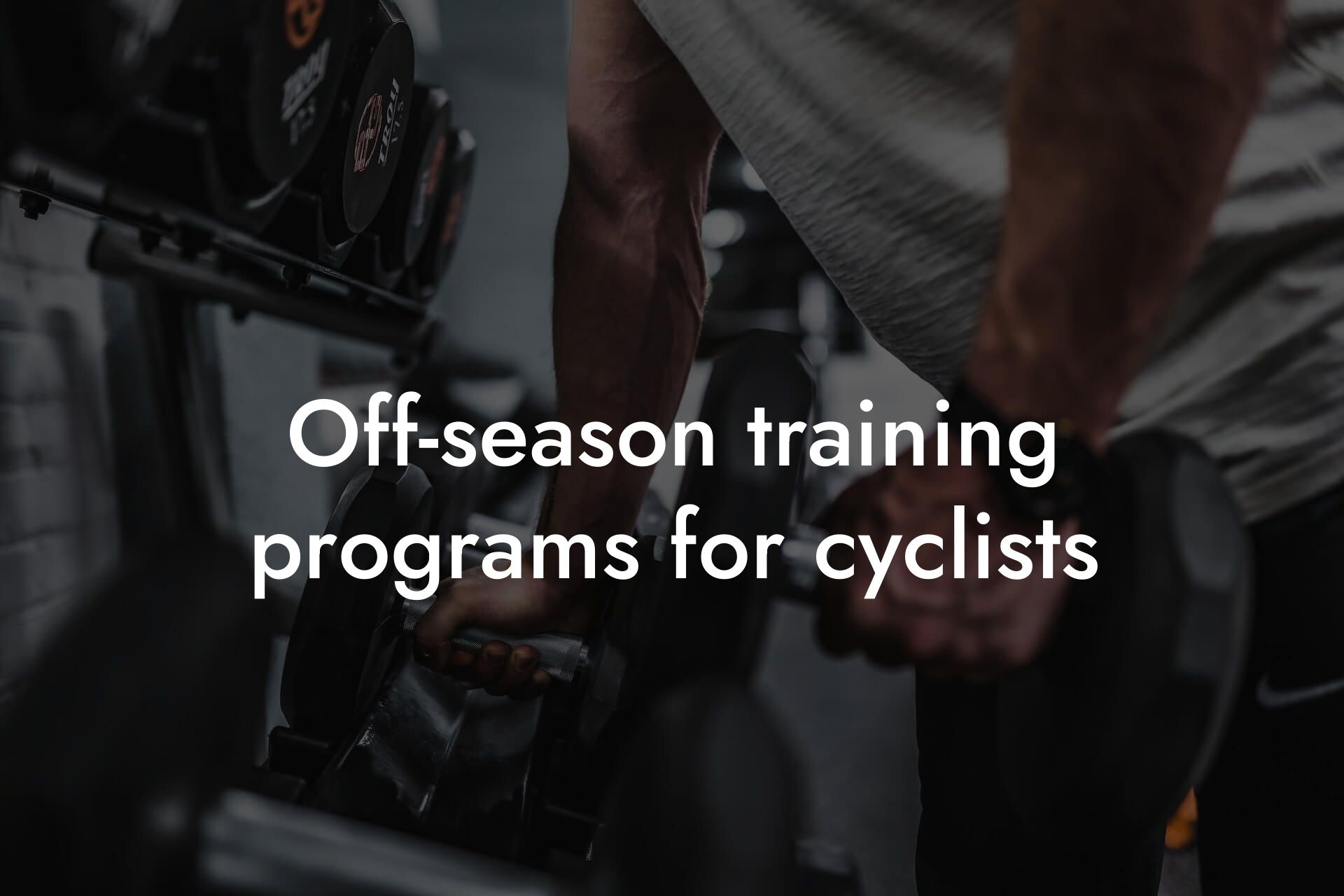As a cyclist, you know that intense racing can take a toll on your body. The physical demands of cycling can lead to fatigue, muscle soreness, and decreased performance if not properly addressed. At Tano Performance Group, we understand the importance of recovery in achieving optimal physical performance. In this article, we'll explore the best recovery strategies for cyclists after intense races, helping you to bounce back stronger and faster.
Table of Contents
Immediate Post-Race Recovery
After an intense race, it's essential to focus on immediate recovery strategies to help your body repair and adapt. Within 30-60 minutes after crossing the finish line, prioritize the following:
1. Rehydration: Drink 16-20 ounces of water or a sports drink for every pound of body weight lost during the race. This helps replenish lost fluids and electrolytes.
2. Refueling: Consume a mix of carbohydrates and protein within 30-60 minutes to replenish energy stores and support muscle repair. Aim for a 3:1 or 4:1 carb-to-protein ratio.
3. Compression Garments: Wear compression socks, sleeves, or tights to improve blood flow and reduce muscle soreness.
Active Recovery Techniques
Active recovery techniques help promote blood flow, reduce muscle soreness, and accelerate the removal of waste products. Try incorporating the following into your recovery routine:
1. Light Cycling: Engage in low-intensity cycling, such as a gentle spin or easy ride, to promote blood flow and help your body clear out waste products.
2. Foam Rolling and Self-Myofascial Release: Use a foam roller or your own body weight to release tension in your muscles, particularly in areas like your legs, glutes, and lower back.
3. Gentle Stretching: Perform gentle, static stretches to improve flexibility and reduce muscle tension. Focus on your major muscle groups, including your legs, hips, and lower back.
Rest and Sleep
Adequate rest and sleep are crucial for recovery. During intense training and racing, your body accumulates fatigue, and adequate rest allows your body to repair and adapt. Ensure you:
1. Get Enough Sleep: Aim for 7-9 hours of sleep each night to help your body recover from the physical demands of cycling.
2. Take Rest Days: Incorporate rest days into your training schedule, allowing your body to recover and rebuild.
Nutrition and Supplementation
A well-balanced diet and strategic supplementation can significantly impact your recovery. Focus on consuming:
1. Anti-Inflammatory Foods: Include foods rich in antioxidants, such as berries, leafy greens, and fatty fish, to help reduce inflammation and oxidative stress.
2. Omega-3 Rich Foods: Consume foods high in omega-3 fatty acids, like salmon, walnuts, and chia seeds, to support anti-inflammatory processes.
3. Probiotics: Take a probiotic supplement or consume probiotic-rich foods, such as yogurt and kefir, to support gut health and immune function.
Massage and Physical Therapy
Massage and physical therapy can be highly effective in promoting recovery and reducing muscle soreness. Consider:
1. Sports Massage: Regular sports massages can help reduce muscle tension, improve circulation, and promote recovery.
2. Physical Therapy: Work with a physical therapist to address any underlying issues, such as muscle imbalances or biomechanical inefficiencies, that may be contributing to fatigue or injury.
Cold Water Immersion and Contrast Showers
Cold water immersion and contrast showers can help reduce inflammation, improve recovery, and enhance athletic performance. Try:
1. Cold Water Immersion: Spend 10-15 minutes in cold water (50-55°F) to reduce inflammation and muscle soreness.
2. Contrast Showers: Alternate between hot and cold water temperatures to promote blood flow, reduce inflammation, and enhance recovery.
Compression and Elevation
Compression and elevation can help reduce swelling, improve circulation, and promote recovery. Try:
1. Compression Sleeves and Stockings: Wear compression sleeves and stockings to improve circulation and reduce swelling.
2. Elevation: Elevate your legs above the level of your heart to reduce swelling and promote blood flow.
Monitoring and Adjusting
Regularly monitor your body's response to training and racing, making adjustments as needed. Pay attention to:
1. Heart Rate Variability: Track your heart rate variability to gauge your body's response to stress and recovery.
2. Performance Metrics: Monitor your power output, speed, and other performance metrics to ensure you're recovering adequately.
3. Body Composition: Regularly assess your body composition using DEXA scans or other methods to track changes in lean mass, body fat, and bone density.
Frequently Asked Questions
What are the most important things to do immediately after an intense cycling race?
Immediately after an intense cycling race, it's crucial to prioritize recovery by replenishing energy stores, rehydrating, and reducing muscle soreness. This can be achieved by consuming a mix of carbohydrates and protein within 30-60 minutes of finishing the race, followed by a gentle cool-down ride or stretching exercises to promote blood flow and reduce muscle stiffness.
How long does it take for a cyclist to fully recover from an intense race?
The recovery time for a cyclist after an intense race can vary depending on individual factors such as fitness level, race duration, and intensity. Generally, it can take anywhere from 2-14 days for a cyclist to fully recover, with most cyclists experiencing significant improvements in performance within 3-5 days.
What role does nutrition play in post-race recovery?
Nutrition plays a vital role in post-race recovery, as it helps to replenish energy stores, repair damaged muscles, and support the immune system. A balanced diet that includes adequate amounts of carbohydrates, protein, and healthy fats can help to promote recovery and reduce muscle soreness.
What are some effective ways to reduce muscle soreness after an intense cycling race?
Effective ways to reduce muscle soreness after an intense cycling race include gentle stretching exercises, foam rolling, self-myofascial release, and using compression garments or recovery boots. Additionally, incorporating anti-inflammatory foods and supplements, such as omega-3 fatty acids and turmeric, into your diet can also help to reduce muscle soreness.
How can compression garments and recovery boots aid in post-race recovery?
Compression garments and recovery boots can aid in post-race recovery by improving blood flow, reducing muscle soreness, and promoting lymphatic drainage. This can help to reduce inflammation, improve muscle function, and enhance overall recovery.
What is the importance of sleep in post-race recovery?
Sleep is essential in post-race recovery, as it allows the body to repair and adapt to the physical demands of the race. During sleep, the body repairs damaged muscles, rebuilds energy stores, and consolidates memories, making it a critical component of the recovery process.
How much sleep do cyclists need after an intense race?
Cyclists need 7-9 hours of sleep after an intense race to allow for adequate recovery and adaptation. This can be achieved by establishing a consistent sleep schedule, creating a sleep-conducive environment, and avoiding stimulating activities before bedtime.
What are some effective ways to manage stress and anxiety after an intense cycling race?
Effective ways to manage stress and anxiety after an intense cycling race include practicing relaxation techniques such as deep breathing, meditation, or yoga, engaging in low-intensity activities such as walking or light stretching, and seeking social support from friends, family, or a sports psychologist.
How can cyclists avoid overtraining after an intense race?
Cyclists can avoid overtraining after an intense race by gradually increasing training intensity and volume, incorporating rest days and active recovery sessions, and monitoring physiological markers such as heart rate and power output. Additionally, working with a coach or trainer can help to develop a structured training plan that balances training and recovery.
What are some common mistakes cyclists make during the recovery process?
Common mistakes cyclists make during the recovery process include rushing back into intense training, neglecting nutrition and hydration, and failing to prioritize sleep and relaxation. Additionally, ignoring signs of fatigue, pain, or illness can also hinder the recovery process and increase the risk of injury or illness.
How can cyclists incorporate strength training into their post-race recovery?
Cyclists can incorporate strength training into their post-race recovery by focusing on low-intensity exercises that target the core, glutes, and legs. This can help to improve muscle function, reduce muscle imbalances, and enhance overall cycling performance.
What are some effective ways to stay motivated during the recovery process?
Effective ways to stay motivated during the recovery process include setting realistic goals, celebrating small victories, and finding a training buddy or support group. Additionally, incorporating cross-training activities such as running, swimming, or yoga can help to maintain a sense of purpose and variety during the recovery process.
How can cyclists use data and analytics to inform their recovery strategy?
Cyclists can use data and analytics to inform their recovery strategy by tracking physiological markers such as heart rate, power output, and sleep quality. This can help to identify patterns and trends that can inform training and recovery decisions, and optimize overall performance.
What are some common recovery strategies used by professional cyclists?
Common recovery strategies used by professional cyclists include incorporating rest days and active recovery sessions, using compression garments and recovery boots, and prioritizing nutrition and hydration. Additionally, many professional cyclists also use advanced recovery techniques such as cryotherapy, electrostimulation, and massage therapy.
How can cyclists balance recovery with other aspects of their life?
Cyclists can balance recovery with other aspects of their life by prioritizing time management, setting realistic goals, and communicating with friends, family, and colleagues. Additionally, incorporating recovery activities into daily routines, such as stretching or foam rolling during commercial breaks, can also help to optimize recovery.
What are some effective ways to stay hydrated during the recovery process?
Effective ways to stay hydrated during the recovery process include drinking water or sports drinks within 30-60 minutes of finishing the race, consuming electrolyte-rich foods and drinks, and monitoring urine output and color. Additionally, incorporating hydrating foods such as watermelon and cucumbers into the diet can also help to optimize hydration.
How can cyclists use mental rehearsal to aid in post-race recovery?
Cyclists can use mental rehearsal to aid in post-race recovery by visualizing themselves performing at their best, rehearsing positive self-talk, and focusing on relaxation and calmness. This can help to reduce stress and anxiety, improve mood, and enhance overall recovery.
What are some common myths about post-race recovery?
Common myths about post-race recovery include the idea that cyclists need to "push through" pain and fatigue, that ice baths are essential for recovery, and that stretching is only necessary after intense exercise. It's essential to separate fact from fiction and prioritize evidence-based recovery strategies.
How can cyclists use social media to aid in post-race recovery?
Cyclists can use social media to aid in post-race recovery by connecting with other athletes, sharing recovery tips and strategies, and seeking support and motivation. Additionally, following sports psychologists, coaches, and recovery experts can also provide valuable insights and resources to aid in the recovery process.
What are some effective ways to incorporate active recovery into a training plan?
Effective ways to incorporate active recovery into a training plan include incorporating low-intensity rides, cross-training activities such as running or swimming, and strength training exercises. This can help to maintain cardiovascular fitness, reduce muscle soreness, and enhance overall recovery.
How can cyclists use technology to aid in post-race recovery?
Cyclists can use technology to aid in post-race recovery by tracking physiological markers such as heart rate and sleep quality, using recovery-focused apps and software, and incorporating wearable devices such as GPS watches and fitness trackers. This can help to optimize recovery, reduce injury risk, and enhance overall performance.
What are some effective ways to stay flexible and mobile during the recovery process?
Effective ways to stay flexible and mobile during the recovery process include incorporating stretching exercises, foam rolling, and self-myofascial release. Additionally, incorporating activities such as yoga or Pilates can also help to maintain flexibility and mobility.
Here are some related articles you might love...
- Off-season training programs for cyclists
- Bone density and injury prevention for cyclists
- Using DEXA scans to monitor cyclist health and performance
- Nutrition tips for endurance during long cycling races
- Strength training for cyclists to improve power output
- The importance of body composition in cycling performance
- Reducing body fat for better power-to-weight ratio in cycling
- The role of muscle mass in cycling endurance
- Hydration and nutrition for optimal cycling performance
Zak Faulkner
Zak Faulkner is a leading authority in the realm of physical health and body composition analysis, with over 15 years of experience helping professionals optimise their fitness and well-being. As one the experts behind Tano Performance Group, Zak has dedicated his career to providing in-depth, science-backed insights that empower clients to elevate their physical performance and overall health.
With extensive knowledge of DEXA technology, Zak specializes in delivering comprehensive body assessments that offer precise data on body fat, muscle mass, bone density, and overall physique. His expertise enables individuals to make informed decisions and achieve their fitness goals with accuracy and confidence. Zak’s approach is rooted in a deep understanding of human physiology, combined with a passion for helping clients unlock their full potential through personalised strategies.
Over the years, Zak has earned a reputation for his commitment to excellence, precision, and client-focused service. His guidance is trusted by top professionals who demand the best when it comes to their health. Whether advising on fitness programs, nutritional strategies, or long-term wellness plans, Zak Faulkner’s insights are a valuable resource for anyone serious about taking their health and fitness to the next level.
At Tano Performance Group, Zak continues to lead our Content Team revolutionising how professionals approach their physical health, offering unparalleled expertise that drives real results.




